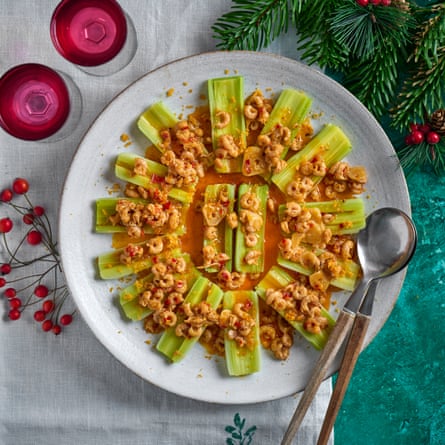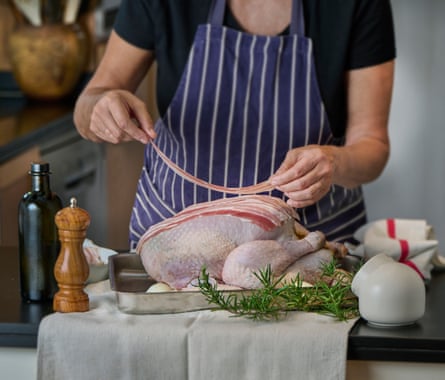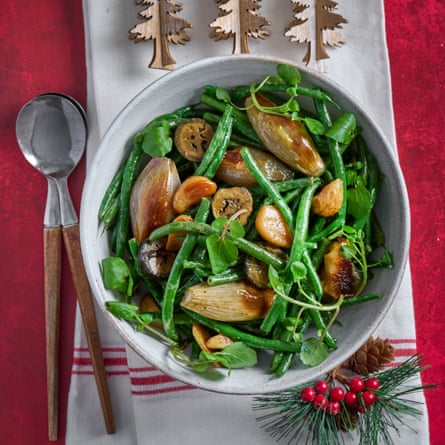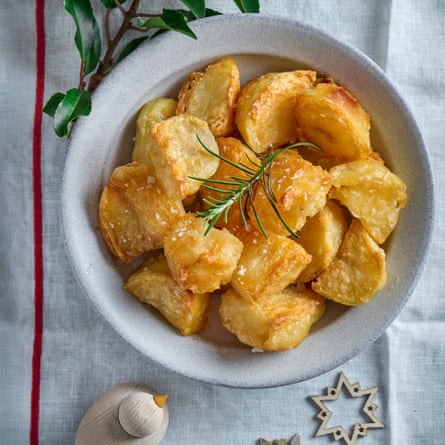Christmas is a great time of year, isn’t it? As a child in New Zealand, I found it so exciting to sit at a big table that was beautifully laid with candles, tangerines and walnuts. My mother used to send us out to chop down the Christmas tree, so we’d go off, find a sappy pine, saw it down and carry it home.
The tree is still very important to me. Fergus and I have been collecting decorations forever There’s always a mouse in a pink dress sitting at the top with a light under her skirt, and tinsel, though we don’t put candles on the tree like we used to when I was a kid.
Christmas is about being together and treating yourself and having a jolly time – and having a few drinks, maybe. We go to Wiltshire each year and we usually have friends over, as well as family. On Christmas Day, we get up, have breakfast and then sit down to do the presents, which takes quite a while. It’s one present at a time – we’re very strict in the Henderson household. We have our big meal at around 3pm – if you leave it much later, you’ll all be asleep, or too drunk. Afterwards, there’s dancing.
For our OFM Christmas menu, we wanted some jazz. It’s an uplifting menu. Some people may find the traditional Christmas dinner a little bit bland, so this one has more of a swing to it. To keep stress levels down, give yourself plenty of time. It’s about being ahead of the game. Start your stuffing around 8am or 9am, and go about things in a gentle way, with everyone helping out. If you’re having turkey, make sure to brine it. It intensifies the flavour, as well as keeping the meat moist.
A turkey is one of those things that needs a lot of loving – you need to be basting it and keeping an eye on it. If you bung it in at a high temperature and just leave it, well, it’s going to be a dry old thing when you serve it.
Leeks, brown shrimp and chilli butter

It’s important to wash the leeks thoroughly as dirt can be lodged between the leaves. Brown shrimp are one of the many jewels we take from the sea, packed with flavour.
Serves 6
leeks 4
grated bottarga 3 tbsp (optional)
For the brown shrimp butter
unsalted butter 150g
fermented chilli ½ tbsp (see recipe below or buy)
chilli flakes 1 pinch
garlic 1 clove, finely sliced
ground mace 1 pinch
brown shrimp 250g
lemon or tangerine juice of ½
salt
black pepper
For the poached leeks, trim the vegetables at both ends, discarding the dark green tops and the root end. Trim away any outer leaves that don’t take your fancy. Then cut each leek into 2 or 3 pieces, depending what size you want.
Bring a large pot of salted water to a boil. Turn it down a little, so the boil is not too vigorous. Poach the cleaned and prepared leeks for around 8 to 10 minutes, until tender. You don’t want them crunchy. Take them out of the poaching liquor and leave to cool. I don’t refresh in icy water as I feel it makes them waterlogged, but it is an option – especially if you overcook them. Set aside until needed (or bring to room temperature, if prepared in advance).
To make the shrimp butter, firstly clarify the butter. Heat the butter gently in a pan and with a ladle skim the top froth off, then slowly pour the butter away from the milk solids at the bottom, discarding the milk solids.
Pour the clarified butter back in your pan, add the fermented chilli, chilli flakes, finely sliced garlic and mace. When the butter starts to heat and the spices are fragrant, add the shrimp and cook for 2 minutes before adding the lemon or tangerine juice.
Finish with a pinch of salt and pepper. Taste and check for seasoning.
While you are making the butter, grate the bottarga, if using, and prepare the poached leeks. Slice each leek in half lengthways and take a layer of the inner leaves away. They should be a bright and chirpy green.
Spread the leeks out on a platter, heat the butter, pour the brown shrimp butter over the top and, if using, finish with grated bottarga.
Fermented chilli paste
I’m rather sensitive to chilli, but also love the layers of flavour it brings to so many dishes. If you are looking for a gentler heat, you can deseed your chillies or soak them in cold water for an hour; this will dampen the fire.
Makes 350g
red chillies 10
garlic 2 cloves
salt 1 tsp
olive oil 60 ml
cider vinegar 60ml
Wash the chillies and trim the stalks. Split them down the middle. Remove the seeds if you want a milder sauce.
Roast them for 8 minutes at 180C fan/gas mark 6, just until they start to get a little colour. This will bring a nuttier flavour.
Put the chillies, garlic and salt in a food processor, give them a good blitz, then add the other ingredients and blitz until you have a smooth paste. Put in a sterilised airtight jar and leave in a cool spot for 5 days to ferment. Once fermented, keep in the fridge for up to 3 months.
Brining the turkey
Brine the turkey 24 hours in advance. Remove the giblets and liver and keep to one side.
Serves 6
turkey 1, about 4-5kg, based on what the butcher has
For the harissa and buttermilk brine
salt 100g
sugar 50g
lemon peel 2 strips
harissa 250g
buttermilk 1.5 litres
water 2 litres
Mix together all the brine ingredients. Put the turkey in a large plastic bag and add the brine. Mix it all around the bird, inside and out. Place in a sealable container large enough for the bird and leave for 24 hours in the fridge. Turn a few times.
Wild rice, chestnut and apple stuffing
Sobrasada is a spicy, spreadable pork sausage, a wonderful product from Spain, a joy to cook with and can be used instead of olive oil and butter.
This stuffing can be done the day before, left in the fridge overnight, then warmed up a little before stuffing the bird. It is my favourite part of a Christmas feast. You will probably have too much stuffing, but it’s ideal for leftovers.
Serves 6
wild red rice 180g
chicken stock 250-500ml (this is to cook the rice for the stuffing mixture, and any leftover can be put at the bottom of the roasting tray with the turkey)
sobrasada 150g
shallots 150g, peeled, sliced thinly
leeks 150g, peeled, washed, trimmed and sliced thinly
celery 150g, washed, sliced thinly
sage 15g, finely chopped
thyme 15g, finely chopped
curly parsley 15g, finely choppped
garlic 2 cloves, finely chopped
apple brandy 100ml (or marsala or port)
sausage meat 200g
turkey livers 100g, finely chopped (from the turkey giblets)
vacuum packed chestnuts 180g, roughly chopped
apples 180g, sliced into chunks; Fergus leaves the skin on, up to you
egg 1, beaten
breadcrumbs 150g (Japanese panko breadcrumbs are great or, even better, sourdough a few days old, whizzed into crumbs)
salt and pepper
Firstly, prep all the ingredients. Cook the red wild rice in chicken stock or water. The best way to do this is by ratio: for every 1 cup of rice, you’ll need 2 cups of liquid, and a pinch of salt.

Bring the rice to a boil with a firm lid on, and once boiling turn down to the lowest heat, cook for 50 minutes until all the liquid is absorbed, and the rice is tender. If the rice is drying out you can always add a splash more liquid.
In a good-sized pan, gently heat the sobrasada, add the shallots, sweating these down for several minutes. Once they soften, add the leeks, celery, herbs and garlic.
Once these soften and start to get involved together, add a ladleful of the leftover chicken stock and the brandy, then reduce for a few moments. After that, turn the heat to minimum. If you are making this the day before, cool your rice and onion mixture before the next step.
On a very low heat, mix through the sausage meat, chopped livers, chestnuts and apple, then immediately remove the mix from the heat. Stir through the egg, then add the breadcrumbs to bring it all together. It should be moist but coming together. Fry a little in a pan and have a taste to check the seasoning, and adjust as needed.
Christmas Day: roast turkey and all the trimmings
Fergus likes to be up and getting the whole process happening. You can take the bird out of the brine and leave it to come up to room temperature, then go back to bed. I wouldn’t as I love the feeling of being ahead of the game. Cooking takes time and the more time you give it, the better the results.
Roast stuffed turkey

turkey 1, brined (see above)
wild rice stuffing (see above)
white onions 3, peeled
chicken stock 150ml
streaky bacon 150g
Firstly, take the bird out of the brine, wiping off the excess. Leave it for at least an hour to come up to room temperature and, part way through, bring out your stuffing (if you’ve made it ahead) so it is at a similar temperature. Otherwise, you can make the stuffing as the bird comes to room temperature.
Preheat the oven to 180C fan/gas mark 6. Generously fill the cavities of the turkey with stuffing at both ends so it bulges out. (Any leftover stuffing can be baked in a well greased roasting tin at 180C fan/gas mark 6 for 40-50 minutes.)
Slice the onions in half and place in a large baking tray, then place your stuffed turkey on top of them. Pour a ladle of chicken stock into the tray. It’s helpful to have a baking tray with reasonable sides so you’re not throwing liquid all over the floor.
Cover the bird with the strips of bacon as if you are wallpapering. They will generally fall off but they have helped by being a breast protector. Then cover the bird and tray with foil.
Roast the turkey in the oven at 180C fan/gas mark 6 for an hour, then turn down to 150C fan/gas mark 3-4 and cook for 2 hours. Keep adding a little stock to the base and get that turkey baster out and baste every now again.
One rule for cooking turkey is for every kg of meat, roast at 180C fan/gas mark 6 for 30 minutes. If you are using a thermometer, the temperature at the thickest part should be 65C to 70C. If not using a thermometer, use a slim, sharp knife or metal prong and insert into the fattest part of the leg. The juices should run clear and be piping hot, rather than warm.
If the bird and bacon is not bronzed on top, take the foil off and give it a little heat to brown the outside.
Leave to rest for an hour, loosely covered with foil and hopefully away from drafts. This is when the magic happens, the bird relaxes and the juices flow. This is also your moment to finish all the other dishes.
Green beans, roast shallots and pickled walnut dressing

shallots 240g, peeled and halved lengthways
garlic 6 cloves, peeled, left whole
olive oil
green beans 600g, topped and tailed
watercress 150g, trimmed of any thick woody stalks
For the dressing
dijon mustard 1 tbsp
sherry vinegar 35ml
lemon juice of ½
Worcestershire sauce 1 tsp
olive oil 220ml
pickled walnuts 120g
Preheat the oven to 180C fan/gas mark 6.
Place the prepared shallots and garlic in a baking dish, season with salt and pepper and toss in a little olive oil. Cover the dish with tin foil, then bake for 40 minutes until soft. Take the foil off and pop back in the oven for 10 minutes to brown.
Watch them and make sure they don’t burn. You might need to drop the temperature a bit.
Meanwhile, make the dressing. In a small bowl whisk together the mustard, vinegar, lemon juice and Worcestershire sauce, then slowly whisk in the olive oil. Lastly, slice the pickled walnuts in thin rounds and fold in. Set aside until needed.
In a large pan, boil salted water, add the green beans and cook for 3-5 minutes, until just cooked – not crunchy and not mushy.
Drain and toss the beans in the shallots and garlic. Carefully dress with the pickled walnut dressing and finally toss through a little watercress. Transfer to a bowl or dish and serve.
Cranberry and red pepper sauce
This is quite racy cranberry sauce, bringing in quite a few strong flavours to complement the cranberries.
red peppers 2
fresh or frozen cranberries 200g
demerara sugar 60g
oranges 2, zested and juiced, about 120ml of orange juice
ginger 1 tsp, grated
cinnamon 1 tsp or 2cm stick
cider vinegar 1 tsp
salt ½ tsp
First, char your peppers. You can brown the skins over a gas flame, or under the grill, until they are blackened. Pop them in a container with a lid to help steam off the skins. When cool enough to handle, carefully take off the skins, then deseed them and slice the flesh.
In a saucepan, over a low heat, mix the cranberries, sugar and orange zest and juice (if necessary, top it up a bit with water). Add the ginger, cinnamon, vinegar and salt. Simmer for 10-15 minutes. The sauce will start to thicken.
Lastly, add your peppers and mix all the ingredients together. You can prepare this sauce a few days ahead and leave in a container with a lid, refrigerated, until you need it.
Roast cauliflower with yoghurt and pomegranate dressing

This whole baked cauliflower is a sparkling vegetarian centrepiece. When I was testing this dish, I popped it into our wood-burning pizza oven and it browned up very nicely, and gave it a lovely flavour.
Serves 4
olive oil 70ml, plus extra for the cauliflower
red onions 2, peeled and sliced into 1cm slices
cauliflower 1 large, with the leaves on
sea salt 1 tsp
For the dressing
yoghurt 200ml (dairy or plant-based)
tahini 2 tbsp
garlic 1 clove, minced finely
sumac 1 tsp (or 1 tbsp of lemon juice)
nigella seeds 1 tsp
sea salt ¼ tsp
black pepper pinch of freshly ground
pomegranate seeds of 1
mint 1 handful, picked and washed
olive oil a splash
Heat the oven to 200C fan/gas mark 7.
Take a heavy pan or cast-iron pot (big enough to fit the whole cauliflower) and add the 70ml of olive oil and the onions. Cook for 5 minutes until they soften.
Wash the cauliflower (you don’t need to dry it). Keep the leaves on and trim the bottom, so it sits flat in your pot.
Rub the cauliflower all over with the extra olive oil, salt and pepper. Place it in the middle of your softened onions, add a ladle of water, about 30ml – this will stop the onions burning and help steam the cauliflower.
Pop the pot into your hot oven for 15 minutes. After that, check and make sure it’s not getting too much colour – if it is, cover with foil – then turn down the oven to 160C fan/gas mark 4 and cook for a further 15 minutes.
Once cooked it should be a bronzed colour and a spike or slim, sharp knife should slide in easily from the bottom.
For the dressing, whisk together the yoghurt, tahini, garlic and sumac (or lemon juice), then add the spices and season. Lastly, add most of the pomegranate seeds and shred the mint leaves and add most of them, plus a splash of olive oil. This will make it glisten.
On a platter, place the cauliflower on top of the onions and then pour over the dressing and garnish with the reserved pomegranate seeds and mint. Using a sharp knife cut wedges and serve with spoonfuls of the dressing.
Gravy
turkey juices from the roasting tin
chicken stock
plain flour 1½ tbsp
white wine or madeira 180ml
redcurrant jelly 1 tbsp
The hardest part of the gravy is moving the bird on to a serving platter. As with this whole meal, you’ll need help. Once the bird has been lifted off the roasting tin, you can take the onions off: they can be served with the turkey.
Carefully pour off the fat, loosen all the yummy bits in the tin, add a splash of chicken stock, then the flour, white wine or madeira. Let this bubble away, then add a splash more stock and simmer. Lastly, add a tablespoon of redcurrant jelly, then season. Any leftovers will keep in the fridge.
Roast potatoes

potatoes 1.8kg – preferably king edwards, peeled and cut into large wedges
sea salt 2 tsp
goose fat 200g
Preheat the oven to 180C fan/gas mark 6. Boil the potatoes in salty water until they are firm but can be easily pierced with a sharp knife. Drain, then fluff them up by roughing the edges with a fork; sprinkle with sea salt.
Heat the goose fat in a baking tray and carefully add your boiled potatoes. Place in the oven until nice and crispy – about 50 minutes. You need to turn them occasionally.
Cardamom and orange panna cotta

Serves 6
For the panna cotta
double cream 1.2 litres
orange peel of 1
cardamom pods seeds of 2, crushed
vanilla pod 1
gelatine leaves 3
milk 150ml
icing sugar 100g
apple brandy or calvados 1 tbsp
For the dried fruit compote
lemon verbena tea 750ml (made with bags or leaf)
dried apricots 50g
dried figs 50g
prunes 50g
dried peaches 50g
dried apples 50g
lemon peel 2 strips
orange peel 2 strips
honey 1 tbsp
cinnamon ½ stick
For the dried fruit compote, first make the tea, then strain and, if you have time, set it aside to cool.

In a generous saucepan, add all the remaining ingredients. Cover the fruit with the strained cold tea. Gently bring to a simmer, and cook for about 15 minutes. Leave to cool, before refrigerating until needed. This compote can be left in the fridge for at least a week.
For the panna cotta, in a pan, over a gentle heat, mix 1 litre of the double cream with the orange peel, cardamom and vanilla pod. Simmer for 10 minutes until the cream is infused with flavour.
Soak the gelatine leaves in the cold milk for 8 minutes until soft. Remove the gelatine and stir into the warm cream mix. Pour the mix through a sieve, discard the spices, then scrape out the seeds from the vanilla pod and add them back in. Leave to cool, stirring occasionally. Whip the rest of the double cream with the sifted icing sugar, then add the alcohol. Finally, fold both cream mixtures together, then ladle into 6 x 250ml ramekins. Refrigerate overnight.
To serve, dip the ramekins briefly into a bowl of warm water and turn out on to a plate. Serve the panna cotta with the dried fruit compote in a large bowl for everyone to help themselves.
Margot Henderson is co-owner of Rochelle Canteen, Fergus Henderson is co-owner of St John
Article From & Read More ( Christmas with the Hendersons: Margot’s recipes for a festive feast - The Guardian )https://ift.tt/XVnNmLp
Entertainment
No comments:
Post a Comment